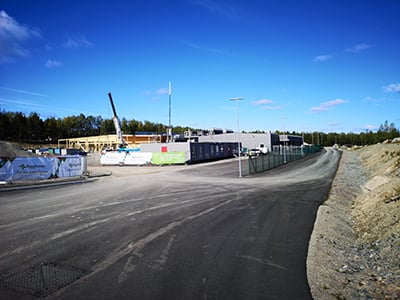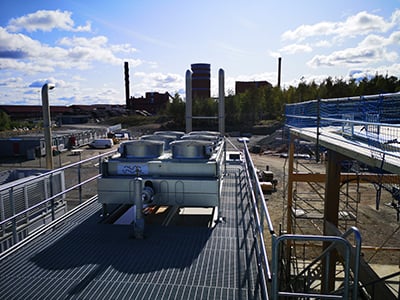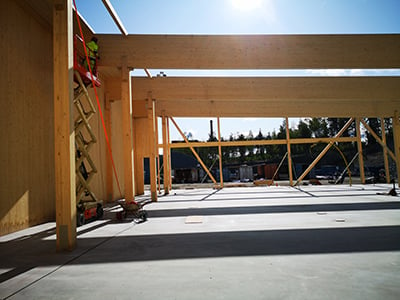Far from being virtual, the internet is a physical thing. Dig below its familiar surface level - the world wide web - and you’ll find solid infrastructure. This infrastructure is collectively consuming unimaginable amounts of electricity. The internet has a dirty secret: it is polluting, greedy and it’s contributing to global warming.
The Commonwealth of Virginia
Virginia is a state that boasts the highest concentration of data centres in the world. There you’ll find data warehouses owned by Amazon, Facebook, Google, Microsoft and many more. Loudoun County Virginia is known as ‘Data Centre Alley’ and around 70% of the world’s web traffic is thought to pass through it on a daily basis.
When it comes to attracting data centre builders, Virginia has a lot going for it: the state has excellent fibre optic infrastructure and access to key internet hubs. Virginia Beach is the landing point for four new transoceanic fibre cable points, connecting them directly to Bilbao, Rio De Janeiro, South Africa and France.
Virginia also boasts reliable and competitively priced power. The problem is, much of Virginia’s electricity is generated by burning fossil fuels. According to the US Energy Information Administration, ‘in 2018, natural gas fuelled 53% of Virginia's electricity net generation; nuclear power provided almost 31%; coal-fuelled about 10% and renewable resources (primarily biomass) supplied nearly 7%.’
A campaign for change
Since 2010, Greenpeace has been documenting the data centre industry’s global energy footprint. The campaigning organisation’s work has resulted in Apple, Facebook and Google making public commitments to accelerate their transition towards renewable energy. This has already resulted in the deployment of more than 10 gigawatts of renewable energy in the U.S. and abroad.
In its 2017 Clean Click report, Greenpeace noted, however: ‘While important progress has been made in driving renewable energy investment in several markets, the dramatic increase in the number of data centres in markets such as Virginia, dominated by utilities that have little to no renewable energy, is driving a similarly dramatic increase in the consumption of coal and natural gas.’
Finding an answer
The answer to the internet’s carbon footprint problem - in microcosm form - might reside just outside the Swedish town of Falun. There, nestling in a seemingly limitless forest and under an infinite blue sky sits the Falun Campus - a data centre being developed by EcoDataCentre.
Like all data centres, it will consume a huge amount of electrical power. That’s unavoidable. Currently, the site - which is Sweden’s largest data centre campus - consists of four operational data centres built on an 80,000m2 of land. The site has 65MW of redundant power. A proposed extension may see two more data centres spring up on 40,000m2 of land. Unsurprisingly, given the area’s beauty, there are strict local development laws that dictate each hall’s physical height and protecting the horizon from industrial blots.

Many natural assets
Falun offers many of the ingredients data centres need to flourish: firstly, there’s an abundance of electricity. The site is served by hydro-electric and wind, whereas Stockholm (to the south) gets most of its power from nuclear. Indeed, the availability of renewable electricity is likely to increase over time as grand scale local consumers (heavy industries like lumber processing and paper making) are shrinking in size due to economic pressures. This leaves increasing supply headroom.
Currently, two independent 30MW supplies serve the site, each connecting the data centre to a different source of power. Should one supply fail, the other can pick up the slack. These power cables don’t cross physically as that would create a single point of failure; instead they each enter from different ends of the site. Similarly, two independent fibre optic cables connect the site to two different internet nodes. All this ensures that uptime can be maximised.
The campus also has many ‘Fort Knox grade’ security features. At the site’s entrance gate, there’s a sentinel line of bollards that retract smoothly into the shining tarmac. These are so thick it would be hard to get your arms around them and harder yet for a lorry to bully its way through. The road from these bollards to the data centre is a zig-zag slalom - again designed to slow vehicles. There are double fences, large stone walls, surveillance radars and full CCTV coverage; inside the reception, the walls are made of ballistic steel and the glass can also stop bullets. To top it off, the whole site is under a no-fly zone.
Finally, outside, it’s not warm. Indeed, by UK standards it is cold and at the time of writing, it’s only an autumn day. This natural coolness means the site’s multiple cooling systems will have to do less work. Further north of Falun - where it’s even colder – you’ll find other data centres basking in the overhead lowering chill. These are owned by Microsoft, Google and friends.
Staying cool
Cooling is one of the data centre industry’s most vexatious issues. By design, data centres are little more than huge halls, packed as densely as specifications will allow, with towering racks of power-hungry computers.
These produce huge amounts of heat; this energy needs to be removed quickly and dependably or the computing hardware will fail. Traditionally, fans and air conditioning are used - these are powered by electricity which contributes to the sites’ demands for electricity. This leads to a curious double whammy of energy greed: data centres turn huge amounts of electricity into computing power and heat and then use yet more electricity to remove this heat. If this electricity is produced by burning fossil fuels, a centre’s carbon footprint can be huge.
Obviously, EcoDataCentre can’t buck the law of physics - its data hall will, when fully packed, inevitably produce huge amounts of heat. However, it does have some unique ways of utilising rather than wasting this heat.

Part of a community
The town of Falun has a municipal heating system. Water is heated and piped around the town so homes, schools and the local hospital can keep warm.
When finished, the data centre will convert its unwanted hot air into hot water and pump it into the town’s heating system. The business will charge for the hot water but, more importantly, it’ll receive back a supply of cold water which can be used to chill the data halls once more.
Across the road from the data centre is a biomass production factory. It turns sawdust, wood chippings and unwanted logs into compressed wood pellets, which are sold and used to keep homes warm. The natural wood used contains a huge amount of water; this needs to be cooked off until the palettes become suitably dry - usually using methane heaters. When complete, the biomass factory will also take the first 10MW of heat from the data centre, again as hot water, and use this to dry the wood instead.
Can we get a carbon neutral web?
With its rare set of local advantages - access to a communal heating system, ample renewable energy and a cool local climate - EcoDataCentre’s Falun campus is a very compelling view of how future datacentres can be carbon neutral. But, will CFOs chose value for money or environmental concerns when signing cheques on big new data centre projects?
At the moment, Sebastian Moss, Deputy Editor of Datacenter Dynamics, says that green credentials are important but aren’t enough to sway buying decisions on their own: ‘[Greenness] is an important factor for some customers - and will increasingly become more important - but price, location, uptime SLAs, certifications and who else is nearby are all potentially bigger factors.’
Moss observes, however, that this status quo may be about to change: ‘It is no coincidence,’ he says, ‘that the consumer-facing companies are the most vocal about how they are going green - they have a clear incentive to look good to their customers and as climate change becomes a public concern, they are more likely to speak loudly about this. This is why, on the eve of the recent climate march (20th September) both Amazon and Google announced large green investments.’
Continuing, he says: ‘…There is still often more 'show' than 'substance' to some of these announcements, though. Amazon's climate change plan is vague, and Microsoft earlier this year joined the Climate Leadership Council, a conservative-led group home to BP, ExxonMobil, Shell, Total and ConocoPhillips.’
‘Ultimately, the solution to a less polluting internet might, ultimately rest with us,’ says Paul Whiston, Managing Director of Whiston Solutions, a built environment specialist. ‘The greater people’s hunger for data storage, processing and transportation, the more the climate will be impacted. I think the datacentre providers are fully aware of their responsibilities and try to minimise their climate impact footprint, this will further improve with R&D, emerging innovations and technology.’
In summary, Whiston says: ‘There needs to be a mind shift in data company strategy but, more importantly, the end user’s awareness and understanding of the service they are using - true social value - comes from a combination of economic and environmental benefit.’


















